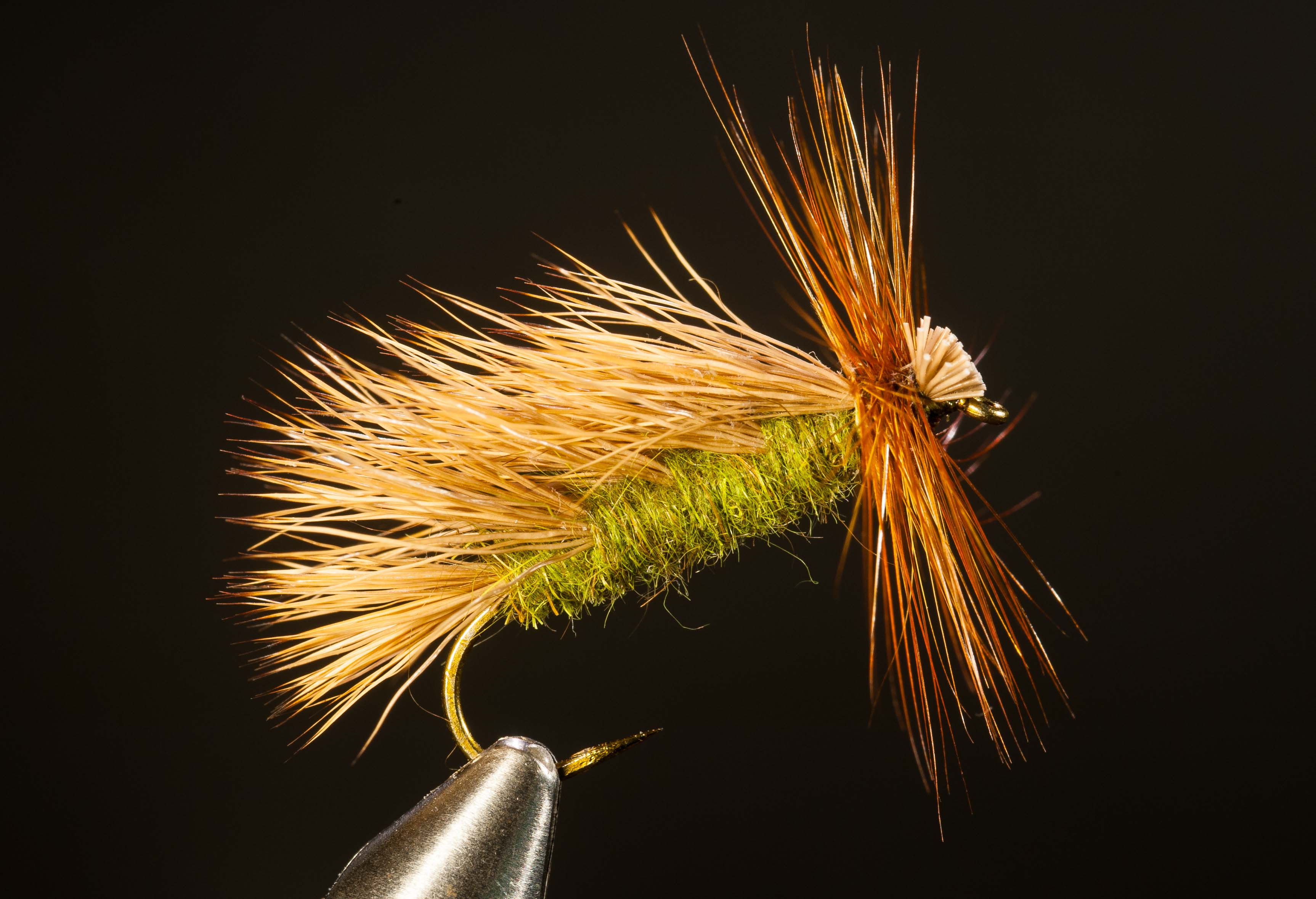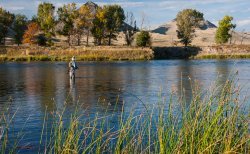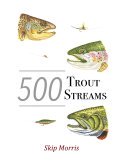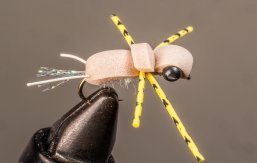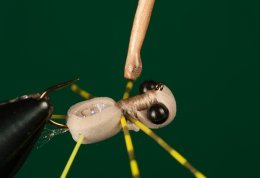Third Thursday Flies
4. Mikulak Sedge
with Skip Morris
For starters, "sedge" is a British term for "caddis." The Mikulak Sedge is a fly from British Columbia, so . . . see?
BCers are fine with both words, "sedge" and "caddis," and judging from the stubborn popularity up there of the Mikulak Sedge, a caddis-imitating dry fly, they're big fans of the bug they name. They should be: caddis hatches in BC lakes can be heavy and exciting. I've seen middling-size caddis popping out all over one interior BC lake, caddis this size scampering across the top of another and rainbow trout jumping them. I've encountered huge Traveler Sedges coming off lakes up there and in a lake far over in the southeast corner of the province, and that's serious business for the fly fisher.
Beyond lakes, there are of course caddis hatches in BC streams and the trout move to them. I know this; I've fished caddis hatches in some of those streams and caught trout by doing so. But only lakes concern us here because, above all, the Mikulak is, to nearly all its believers, a trout-lake fly.
A unique fly too. Using hair wing-butts to suggest an insect head isn't unusual, but building a consolidated hair wing in several sections is.
And the Mikulak is a solid imitation of a caddis adult. Take an underside look at a Mikulak Sedge and you'll see the hackle fibers as legs, the body exposed and thick and neat like a caddisfly's body, the tips of the wing hairs bordering that body and extending well off its back end: all very adult-caddis-like.
The Mikulak is fished mainly to imitate the Traveler Sedge, and the Traveler is the star of BC lake caddis. The enormous bug is here too, in the American West, in Washington and Oregon, in Idaho and Montana, and probably in lakes in other Western states. Wherever this giant caddis hatches, the Mikulak will serve.
Hatches of the Traveler Sedge can be amazing—trout of three pounds, five pounds, even more pounds coming up and grabbing the huge bugs. Big and really big trout coming to a floating fly! You toss your Mikulak out into the action, slide it, pause it, slide it again so it makes another tiny "V" on the water. A great head emerges . . . Three X tippet seems so fragile when you set a Mikulak into a charging, four-pound rainbow, and is.
In Idaho a twitched Mikulak took me a fine rainbow from a famous spring creek. (Heresy . . . yes, I get it.) In Washington it's taken me other rainbows on the Yakima River. Fish it on streams to imitate the October Caddis that's as big as the Traveler or to imitate the giant stoneflies, the Salmonfly and Golden Stone, or just to drum sullen trout up.
Or fish it where its creator, Art Mikulak, apparently intended, on lakes.
Apparently there are a lot of "apparently"s where Mr. Mikulak is concerned.
I dug through my books about flies, including some titles by Canadian authors, and found nothing about the man and his very Canadian-popular fly. So, despite knowing how unreliable internet information can be, and often is, I reluctantly investigated some websites. Apparently Art Mikulak lived in Calgary, Alberta and apparently he liked to trim off the hackles along the underside of his Sedge, which apparently most fly fishers do not. But I vouch for none of that. If you suspect that information to be faulty, take it up with the internet.
As to whether the Mikula Sedge is a cleverly conceived and rightly trusted fly for imitating Traveler Sedges? No question: yes, it definitely is.
MIKULAK SEDGE, GREEN Art Mikulak
HOOK: Standard (or heavy) wire, 2X long, sizes 12 to 6.
THREAD: Olive 6/0 or 8/0.
TAIL: Natural-light elk hair (the tail is really part of the wing).
BODY/WING: Sections of dark-green buoyant synthetic or natural dubbing separating bunches of natural-light elk hair.
HEAD: The cut-short butts of the last, forwardmost wing section.
HACKLE: One, brown. (Trimming the hackle-fibers flat or to a "V" underneath is optional.)
COMMENTS: These colors match the Traveler Sedge. Use whatever colors match whatever insect you're imitating or colors that simply please you.
Click here to hear Skip's interviews on popular podcasts...
*Announcements*
Skip has an essay in Big Sky Journal's annual Fly Fishing issue, called "Montana Hoppers: the Princess and the Brute" released February 1, 2023. Skip rewrote it a bit; I painted and illustrated it here, on our website. Here's the link on our web page to check it out:
Click here to read Skip's essay Montana Hoppers: The Princess and the Brute...
Skip's latest books:
Top 12 Dry Flies for Trout Streams: How, When, and Where to Fish Them, is now available on Amazon as an ebook...check it out! Click on the links below to go to the information page on Top 12 Dry Flies (the link to Amazon is at the bottom of the page...)
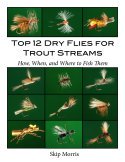 Top 12 Dry Flies for Trout Streams: How, When, and Where to Fish Them
Top 12 Dry Flies for Trout Streams: How, When, and Where to Fish Them
Click here to get more information about
Top 12 Dry Flies for Trout Streams: How, When, and Where to Fish Them (the link to Amazon is at the bottom of the page)...
Top 12 Dry Flies for Trout Streams: How, When, and Where to Fish Them (the link to Amazon is at the bottom of the page)...
Top 12 Nymphs for Trout Streams: How, When, and Where to Fish Them, 2nd Edition, originally published as an e-book only, is now available on Amazon as a paperback...check it out! Click on the links below to go to the information page on Top 12 Nymphs (the link to Amazon is at the bottom of the page...)
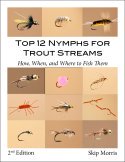 Top 12 Nymphs for Trout Streams: How, When, and Where to Fish Them (2nd Edition)
Top 12 Nymphs for Trout Streams: How, When, and Where to Fish Them (2nd Edition)
Click here to get more information about
Top 12 Nymphs for Trout Streams: How, When, and Where to Fish Them (2nd Edition). . .
Top 12 Nymphs for Trout Streams: How, When, and Where to Fish Them (2nd Edition). . .
Click here to get more information about Skip's e-book,
500 Trout Streams...
500 Trout Streams...
Skip's latest paperback book:
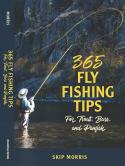 365 Fly Fishing Tips for Trout, Bass, and Panfish
365 Fly Fishing Tips for Trout, Bass, and Panfish
Click here to get more information about Skip's latest book,
365 Tips for Trout, Bass, and Panfish...
365 Tips for Trout, Bass, and Panfish...
Print Skip's chart for FREE:
Skip Morris's Trout-Fly Proportion Chart
Go to Skip Morris's Trout Fly Proportion Chart
Skip's Predator is available to buy...
Skip's ultra-popular Predator—a hit fly for bluegills and other panfishes and largemouth bass (also catches smallmouth bass and trout)—is being tied commercially by the Solitude Fly Company.
The Predator
CLICK HERE to learn more about or to purchase the Predator...
Learn to Tie Skip's Predator
Do you want to tie the Predator?
Tying the Predator
Skip shows you how to tie it on his YouTube Channel link, listed below:
CLICK HERE to see Skip's detailed video on how to tie the Predator...
